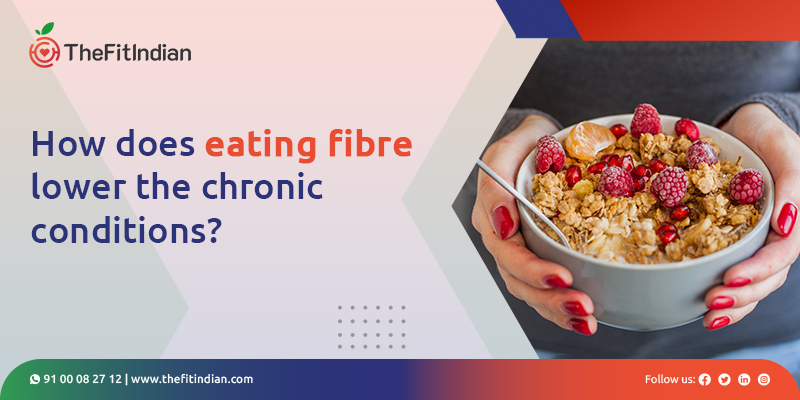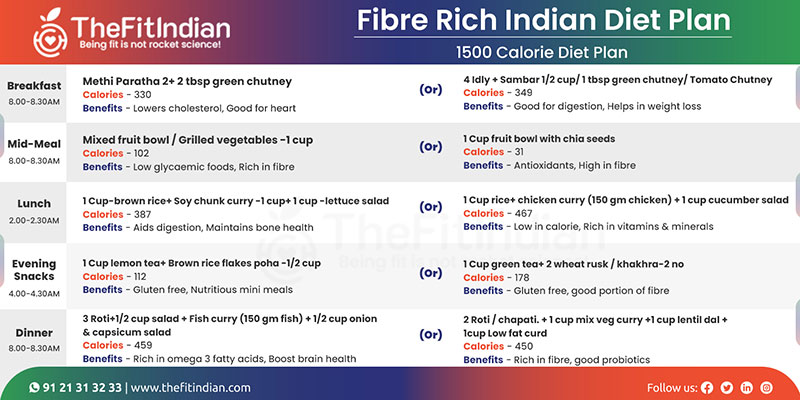How does eating fiber lower the chronic conditions?
Reviewed by: Dr. T S Deepthi Sarojini | Author: Manoja Kalakanti
The best-known benefit of dietary fiber, primarily found in fruits, vegetables, whole grains, and legumes, is its ability to prevent or cure constipation. Additionally, fiber-rich foods can help you maintain a healthy weight and reduce your risk of developing diabetes, heart disease, and cancer.

What are dietary fibers?
Dietary fiber is a term used to describe nutrients in the diet that, despite not being digested by gastrointestinal enzymes, play a crucial role. Fibre, which is mostly found in fruits, vegetables, whole grains, and legumes, provides several health advantages, including lowering the risk of diabetes and heart disease.
Roughage or bulk, another name for dietary fiber foods, refers to the components of plant meals that your body cannot digest or absorb. Your body doesn’t process fiber like other meal ingredients like lipids, proteins, or carbohydrates that it breaks down and absorbs. Instead, it exits your body through your colon, small intestine, and stomach, largely undamaged.
Dietary fibers are divided into two sections:
Soluble fibers: Fibre that is soluble in water turns into a gel-like material in the digestive tract. Oats, barley, almonds, seeds, lentils, peas, beans, apples, oranges, carrots, and psyllium husk are examples of foods that contain this type of fiber. It is well known that soluble fiber can decrease cholesterol, control blood sugar, and encourage the development of good gut bacteria.
Insoluble fibers: Insoluble fiber gives the stool volume and does not dissolve in water. Foods including whole grains, vegetables, and fruits include this type of fiber. Insoluble fiber has been shown to lower the incidence of colon cancer, encourage regularity, and aid in preventing constipation.
How does eating fiber lowers chronic conditions?
Consuming fiber has been associated with a lower risk of several chronic diseases, such as heart disease, diabetes, and cancer. Although the exact mechanisms by which fiber can help reduce the risk of such illnesses are complex and still not fully understood, several factors are believed to be responsible for these health advantages:
1. Better Digestive Health:
High dietary fiber diets encourage regular bowel movements, which can lower the risk of constipation, diverticulitis, and hemorrhoids. Additionally, fiber can support good gut bacteria growth, reducing inflammation and promoting better digestion.
2. Reduced Cholesterol:
Soluble fiber, which is present in oats, beans, and some fruits and vegetables, can help reduce cholesterol by binding to cholesterol in the digestive tract and inhibiting its absorption into the bloodstream. This can lower the chance of developing heart disease.
3. Reduced Blood Sugar Levels:
Fibre can aid in delaying the digestive tract’s absorption of carbohydrates, which can lessen blood sugar peaks. For those who already have diabetes or who are at risk of getting it, this can be extremely helpful. This is a great dietary fiber benefit.
4. Reduced Inflammation:
One of the frequent underlying causes of many chronic illnesses, inflammation, can be helped by fiber. Fibre may assist in lowering the risk of diseases like heart disease, diabetes, and some types of cancer by reducing inflammation.
It’s crucial to remember that the clear health advantages of fiber may differ based on the type consumed and other individual factors, including general dietary habits, lifestyle choices, and genetics. However, increasing your intake of fiber-rich foods can quickly and efficiently improve your overall health and lower your risk of developing chronic diseases.
Benefits of adding dietary fiber to your diet:
Fibers are a significant element to add to your diet. It has many benefits and can be combined with proteins and vitamins for better results. The benefits of adding dietary fiber foods to your diet are:
1. Assists in weight loss:
Certain fibers can aid in weight loss by decreasing appetite. Some studies suggest that increasing dietary fiber foods can help people lose weight by naturally lowering calorie intake. Fibre can absorb water in the colon, which slows nutrient absorption and heightens feelings of fullness. However, this is dependent on the fiber type. While some soluble fibers can significantly affect weight, others have no effect. Glucomannan is an excellent illustration of a fiber supplement for weight loss.
2. Help in reducing blood sugar:
Foods high in fiber often have a lower glycaemic index than sources of refined carbohydrates, which have had most of their fiber removed. But according to scientists, this property is only present in high-viscosity, soluble fibers. Therefore, you could reduce the amount of blood sugar in your meals containing carbohydrates by including these viscous, soluble fibers. This is crucial, especially if you’re eating a lot of carbohydrates. In this instance, the fiber can lessen the possibility that the carbohydrates will cause the blood sugar level to rise dangerously. Therefore, you should limit your carbohydrate intake if you experience blood sugar problems, mainly if you consume low-fiber, processed carbs like white flour and added sugar.
3. Helps in maintaining bowel health:
A high dietary fiber diet may reduce your risk of developing diverticular disease, which causes tiny pouches in the colon and hemorrhoids. According to studies, a high-fiber diet is likely to reduce the incidence of colorectal cancer. In the colon, some fiber is fermented. Researchers are investigating how this can help to prevent colon illnesses.
4. Helps in gaining healthy weight:
You will probably eat less and feel fuller longer if you consume high-fiber foods instead of low-fiber ones because they are usually more satisfying. Additionally, high-fiber foods take longer to finish and are less “energy dense,” which means they contain fewer calories per unit of food.
Best fiber-rich foods:
1. Whole grains:
Both soluble and insoluble fibers, which are crucial for sustaining good health, can be found in whole grains. Insoluble fibers can assist in promoting bowel regularity and preventing constipation, while soluble fibers can help decrease cholesterol and blood sugar levels. Examples of whole-grain foods are:
- Millets
- Barley
- Brown rice
- Quinoa
2. Vegetables:
Dietary fiber can be found in abundance in vegetables. Vegetables range in their fiber content. However, many are regarded as high-fiber foods. Some examples of high dietary fiber content vegetables are:
- Broccoli
- Sweet potato
- Carrots
- Peas
3. Fruits:
Fruits are a great source of dietary fiber. They are rich in soluble and insoluble fibers, making them perfect for consumption. Some fruits with high dietary fiber content are:
- Raspberries
- Apple
- Avocado
- Orange
4. Fortified oil:
Although they often lack dietary fiber, fortified oils are oils that have been enriched with extra nutrients, like vitamins and minerals. However, if fortified oils have been enhanced with fiber-rich ingredients like psyllium husk, they may contain trace amounts of fiber.
Fiber-Rich Indian Diet Plan :

Summary:
An essential vitamin called fiber may help with weight loss, blood sugar control, gut health, and constipation. The average person does not consume the daily required amount of 25 grams for women and 38 grams for men. To easily increase your daily allowance of fiber, try including any of the items listed above in your diet.
FAQ’s:
The indigestible component of plant meals that passes through our digestive tract, absorbing water on the way and facilitating bowel motions, is known as fiber, sometimes known as roughage.
In one cup of Avocado salad:
Calories: 163
Protein: 3.3 g
Carbohydrate: 5.6 g
Fat: 14.3 g
Fiber: 7.0 g
A list of dietary fiber foods are:
Lentils
Green leafy vegetables
Fortified cereal
Fruits
Yes, Psyllium husk is rich in fiber that may benefit your digestion and heart health.
Oranges by themselves are quite fibrous since they have a lot of pulp. However, juicing the orange declines the fiber content since the pulp is often discarded in the process.
Dietary fiber slows down the rate of sugar absorption, improves insulin sensitivity, reduces the risk of complications, and helps in weight management; hence very useful for diabetic patients.
Depending on variables including age, sex, and level of physical activity, different daily fiber intakes are advised. The following are the general tips for adults:
38 grams of fiber daily for men
25 grams of fiber daily for women
Fiber is an essential part of daily meals since it promotes digestive health, helps control blood sugar levels, reduces cholesterol levels, promotes weight management, and reduces the risk of chronic conditions.
High-fiber foods reduce chronic conditions by improving blood sugar levels, reducing blood sugar levels, lowering cholesterol levels, reducing inflammation, improving weight, etc.
A high-fiber diet may improve general health and lower the risk of developing some chronic diseases, which may lengthen life expectancy. A high-fiber diet is only one of many things that may promote a long and healthy life, but it’s vital to remember that there are many other aspects as well.




Manoja Kalakanti